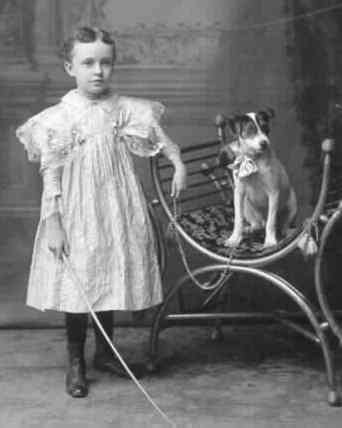pinafore: home wear
Pinafores: Home Wear

Figure 1.--This American boy appears to wear a pinafore over a short sleeved
dress or smock. Presumably this was his normal every day wear at home, before he was
breeched. Boys were less likely to wear pinafores after breeching--even at home.
Note the stripped stockings. The photograph was probably taken in the 1880s, but it may
have been taken as early as the late 1870s.
|
Pinafores were essentially abbreviated smocks worn over other clothes for
meals and play. Pinafores for children, especially boys, were generally
an informal garment designed for informal home wear. For this reason,
the available 19th Century photographic images probably does not reflect the actual extent to
which they were really worn. Mothers usually dressed their children in their best
party outfit for the formal photography of the day.
Conventions
It is not clear for me the cnventins of wearing pinafores at home. Several questions
present themselves. Why for example did a
mother decide on a pinafore rather than a plain everyday dress? Perhaps a pinafore
was worn over an everyday dress as well. Why did a mother select a pinafore rather than
a smock? Were there certain occassions that smocks were required and other occasions
for pinafores?
I believe that social class also affected the use of the pinafore. I believe that
pinafores were primarily worn bu boys in affluent families, nut this is just a suposition
at this time.
Style
Many pinafores were made for everyday wear at home. These were made out of inexpensive materials with simple
designs. These simple pinafores varied in style. Some pinafores in the
mid and
late 19th Century were more like aprons with bib fronts, primarily
covering the front of the dress or smock. Other styles covered almost
all of the dress or smock, except for the sleeves. This of course distinguishes the pinafore. A garment with sleeves would be a smock.
A varierty of stylistic features could be added to the pinafore. Lace trim
could be added around te collar and at the arm openings. Trim could also be added
at or mear the hem. Ofte the waist was elevated and smocking or trim gathering could be added at that point.
The available
photographs may not reflect the actual styles commonly worn at home.
Mothers may have wanted their sons to be photographed in their
most elaborate pinny, rather than an every day pinny. Thus there are relatively few
images available of boys wearing the plainer styled pinafores.
There does not appear to have been any significant stylistic
feature distinguishing the pinafores worn by boys and girls. Boys' dresses
or dress-like tunics, for example, usually had belts. This was
usually not the not the case for pinafores--at least the ones worn at home.
Some boys do seem to have sometimes added belts to their work
pinafores.

Figure 2.--It was not just little boys who wore pinafores in the late
19th Century. This Philadelphia boy in a photograph taken probably in
the 1880s wears a pinafore with fancy sleeves. He looks to be about 8 or
9 years old. Note that the dog has a little bow.
|
Clothing
Only limited information is available on the clothes boys wore with pinafores.
Some information can be discerned from an analasis of available images.
Dresses
It is likely that most boys still in pinafores were boys still in
dresses that had not yet been breeched. The boys pictured on this page for example, do not appear to have
been breeched. This is apparent because if you observe the sleeves, they are
not wearing boyish shirts or even blouses. If they had been breeched, almost
certainly theu would be wearing shirts or blouses with long sleeves.
Pants
However a few available
photographs show that some boys still wore pinafores at home after
breeching. Almost always these boys are wearing kneepants.
Stockings
Most boys in pinafores wear long dark stockings. Some boys wear stripped
stockings.
The fashion of boys
wearing shorter socks did not fully develop until after the turn of the
century, by which time it became less common for boys to wear pinafores.
There are some country differences here. Little boys in dresses were
more likely to wear short socks in Europe, well before the turn of the
Century.
Shoes
Footwear varied. Boys and girls might wear strap shoes or pumps with bows (figure 1). Other children might wear the heavier boot-like lace up or button shoes.
Gender Identification
The lack of gender differentiation in pinafore styles makes it difficult
to determine the gender of the individual children in available photographs.
The only clue often available is the hair styles. Other clues such as pets
and toys are other props are often not available or ambiguous.
Christopher Wagner
histclo@lycosmail.com
Navigate the Historic Boys' Clothing Protective Garments pages:
[Main pinafore page]
[Home pinafores]
[Workhouses]
[Work pinafores]
[Institutions]
[Main smock page]
Navigate the Historic Boys' Clothing Web Site:
[Return to the Main pinafore page]
[Introduction]
[Chronologies]
[Style Index]
[Biographies]
[Bibliographies]
[Activities]
[Country]
[Contributions]
[Frequently Asked Questions]
[Links]
[Boys' Clothing Home]
Created: May 8, 1999
Spell checked: August 2, 1999
Last updated: August 2, 1999

